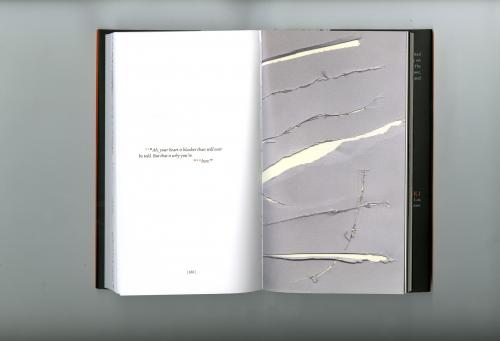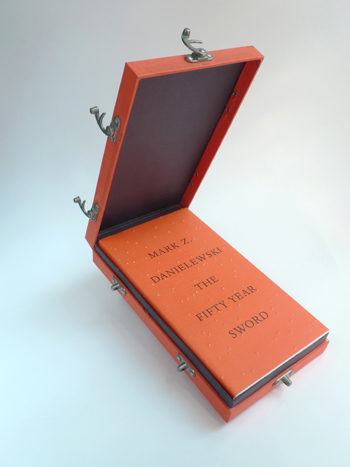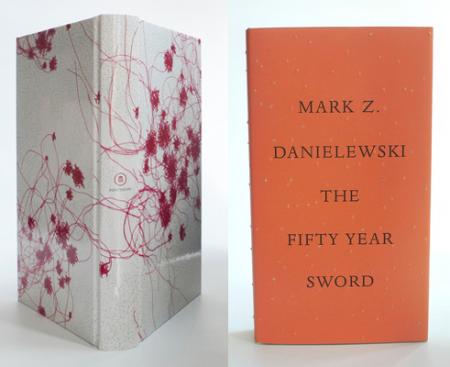The Fifty Year Sword is a tale of Dungeons & Dragons high fantasy, filtered through a modern experimental novella. No wait, I’m not sure that’s it; here, let me try again: The Fifty Year Sword is a Quentin Tarantino revenge story in the vein of Kill Bill, as translated by David Lynch. Or wait! A ghost story by way of post-modernity, illustrated at needlepoint. Maybe: a tower of thread and words, full of obfuscation and dark passions?
Really the best comparison I can make is not a simile (schimile) but rather an appeal to the author’s earlier work—The Fifty Year Sword was written by Mark Z. Danielewski, who wrote House of Leaves, which I believe is the only scary novel. In The Fifty Year Sword, Danielewski continues to cleave to a sense of menace, while telling a story of vendetta through sparse, disintegrating text against a backdrop of macabre stitches.
The story is simple: our protagonist is Chintana, going to the birthday party of the woman her husband cheated on her with. A birthday party held—of all places—in an orphanage. Chintana’s background as a seamstress influences the diction and visual look of the book—and its ultimate conclusion, as a story and a fable— but she isn’t at the center of the bulk of the narrative. That role belongs to the Storyteller, who appears to entertain five children with the story of his quest to find one of the most dangerous weapons ever divised…the Fifty Year Sword. Across The Valley of Salt, The Forest of Falling Notes and The Mountain of Manyone Paths—a valley assault, a forest of note and a mountain of any won paths—the Storyteller travels, to find the Man with No Arms. Along the way our story is told through the device of five narrators, each marked by a color of quotation mark, what the book calls “colophon.”

If anything, Danielewski’sThe Fifty Year Sword reminds me of the experimental writing of Jeff Noon. Have you read Jeff Noon? You really ought to; if you like Mark Danielewski, odds are your brain is wired in the right way to like Noon. His novel Vurt was very important to me in my first year of college; it hit me at the right moment to become a formative part of my young canon. The slurry typos in The Fifty Year Sword, pregnant with meaning…? That is a very Noonian trick.

While screwing with page formatting is very signature Danielewski—being the first thing anyone who picks up House of Leaves will notice—the staggered text cut up by coloured quotation marks is highly reminiscent of Needle in the Groove, where Jeff Noon attempts to evoke the flow of music, of lyrics. The fact that Fifty Year Sword is going for a kind of Greek chorus, following the flow of storytelling, isn’t an accident. Whether or not Noon is an influence on Danielewsi, they are clearly working toward similar ends.
Which is worth addressing—that is, what the book is actually like. I mentioned the visual impact of House of Leaves; it is a book with footnotes so heavy they take up half a page, more, page after page of annotation, both academic and personal; it is a book with text running vertical, or spiraling, or mirrored. The Fifty Year Sword is a clear inheritor of that tradition, with sewing and thread decorating the page. Spacing and layout is as much a part of the story as the words themselves, as are the pictures told in thread and fabric. The work is interdisciplinary, a collage of mediums, and Regina Gonzales, Claire Kohne and Michele Reverte all deserve recognition as Atelier Z, responsible for the stitching in the book.

This is my wheelhouse, I have to admit; the junction of Fantasy and the Uncanny, the part of the Venn diagram where the two overlap and become the Weird. Is the work pretentious? That is a word I hear bandied around whenever experimental fiction is discussed, and I can’t say it is always undeserved…but here I think we can put it to bed. The Fifty Year Sword is playful, certainly, and it tries things that most works of modern fiction don’t, but it doesn’t fail, and it isn’t just for its own sake. The tricks of the tale work, which is what ultimately matters, isn’t it? Recently, this sort of thing has been left to science fiction—your Inceptions and tales of memory loss—but as any fan of Gene Wolfe will tell you, there is plenty of room for deep dark stories at the edge of meaning in the world of fantasy.
 Though I adore House of Leaves, I was turned off by Danielewski’s Only Revolutions, which used many of the same “tricks” to less effect, I thought. The Fifty Year Sword falls in between the two, chronologically; originally published in the Netherlands with only 1000 English copies in 2005, and another 1000 in 2006, it wasn’t until October of 2012 that the book became widely available. I’m hoping that we’ll see more like The Fifty Year Sword from Danielewski; more mayhem tempered by oddity, more textual play anchored in storytelling.
Though I adore House of Leaves, I was turned off by Danielewski’s Only Revolutions, which used many of the same “tricks” to less effect, I thought. The Fifty Year Sword falls in between the two, chronologically; originally published in the Netherlands with only 1000 English copies in 2005, and another 1000 in 2006, it wasn’t until October of 2012 that the book became widely available. I’m hoping that we’ll see more like The Fifty Year Sword from Danielewski; more mayhem tempered by oddity, more textual play anchored in storytelling.
Mordicai Knode’s sword has “solve et coagula” written on the blade, and it is made from spiders’ tears, an angel’s crown and fuligin, the color blacker than black. You can follow Mordicai on Twitter and Tumblr.










